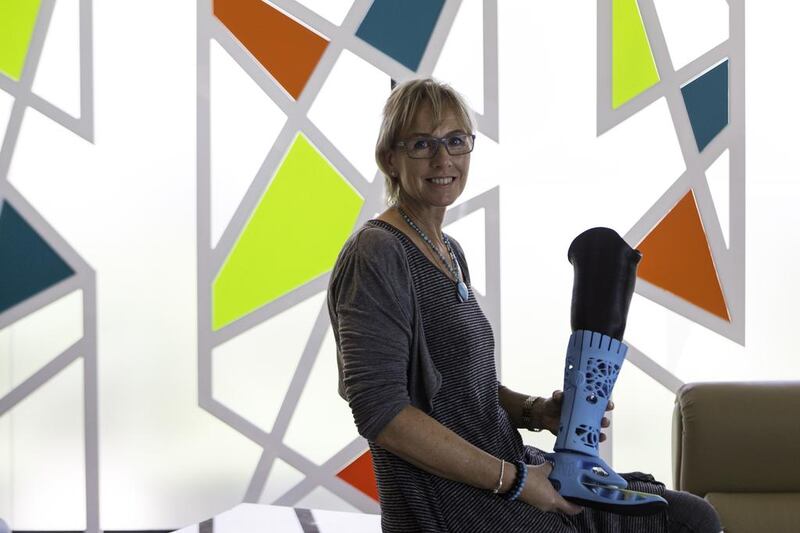DUBAI // Belinda Gatland has a new lease of life thanks to the first 3D-printed prosthetic leg to be developed in the country, which allows her to resume horse riding in comfort.
The prosthesis was donated to the Briton, who has been an amputee for 10 years after complications arising from a riding accident when she was 22.
The 51-year-old suffered necrosis in bone tissue, resulting in her left leg being amputated below the knee.
She has continued to ride horses and run with expensive custom-made limbs but has trialled a 3D-printed leg that could revolutionise the industry and make sports prosthetics more affordable for thousands of amputees.
“I’ve only been wearing this 3D-printed limb for a few days but it’s amazing,” said the Dubai expat.
“It is very comfortable. I could put it on straight out of the machine, rather than go through casting, a test socket and the many different consultations that are needed. There isn’t much I can’t do with this leg.”
Similar to the pinch of a new pair of shoes, a new prosthetic leg takes a bit of time to adjust to, particularly as sports blades can weigh half the 2.5 kilogram general-use limbs.
A standard prosthetic leg costs in the region of Dh11,000, but developers hope to bring the price of 3D-printed alternatives down to about Dh2,500.
Ms Gatland was supported by a fund for injured jockeys in the UK, and had the cost of a prosthetic covered by the UK’s National Health Service. But artificial limbs for running, cycling and other exercise such as riding can cost up to Dh50,000.
While 3D printing is fast emerging in health care, it is relatively new in prosthetics. As costs fall, it is hoped that the technique could offer a cheaper, more convenient option, with tailor-made printed limbs a huge benefit for amputees.
Following her operation, Ms Gatland, who is an equine sports therapist, required six replacement sockets – the attachment inserted into the false limb to fine-tune how the prosthetic works with her body.
With 3D printing, the specifications of the patient can be delivered using a computer to ensure a first-time perfect fit.
It is expected to be a big bonus for child amputees, who outgrow their limbs every few months before they need adjusting, and will make it a quicker and cheaper process for all.
“I’ve been involved in a project to encourage children who have lost a leg to wear blades, and this 3D development could have a similar impact as they are aesthetically more appealing, and colourful,” Ms Gatland said.
“I wear my blades for running, but also with a high heel if I am dressing up for an event.”
Dubai Health Authority and Arab Health facilitated the project and donation of the prosthesis in conjunction with medical firms Prosfit (Bulgaria), Mecuris (Germany) and Mediclinic (UAE). The initiative is part of the 3D Khair initiative, in line with the Year of Giving 2017.
“We are keen to bring in the latest technology in medicine to further bolster patient-centric care and improve the lives of our patients,” said DHA director general Humaid Al Qatami.
“We consider the private sector to be our partner in our endeavours and such collaborative efforts go a long way in bringing modern excellence to Dubai.”
nwebster@thenational.ae







